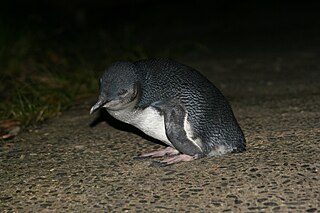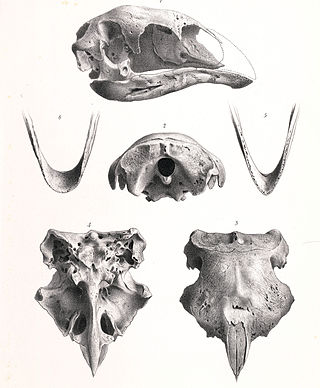
The little penguin is a species of penguin from New Zealand. They are commonly known as fairy penguins, little blue penguins or blue penguins owing to their slate-blue plumage and are also known by their Māori name kororā.

The yellow-eyed penguin, known also as hoiho or tarakaka, is a species of penguin endemic to New Zealand.

Eudyptes is a genus of penguins whose members are collectively called crested penguins. The exact number of species in the genus varies between four and seven depending on the authority, and a Chatham Islands species became extinct in recent centuries. All are black and white penguins with yellow crests, red bills and eyes, and are found on Subantarctic islands in the world's southern oceans. All lay two eggs, but raise only one young per breeding season; the first egg laid is substantially smaller than the second.

Megadyptes is a genus of penguins from New Zealand.

The genus Eudyptula contains two species of penguin, found in southern Australia, Tasmania, and New Zealand. They are commonly known as the little penguin, little blue penguin, or, in Australia, fairy penguin. In the language of the Māori people of New Zealand, little penguins are known as kororā.

The New Zealand merganser, also known as Auckland merganser or Auckland Islands merganser, was a typical merganser which is now extinct.

The Antipodes Islands are inhospitable and uninhabited volcanic islands in subantarctic waters to the south of – and territorially part of – New Zealand. The 21 km2 archipelago lies 860 km to the southeast of Stewart Island/Rakiura, and 730 km to the northeast of Campbell Island. They are very close to being the antipodal point to Normandy in France, meaning that the city farthest away is Cherbourg-en-Cotentin, France.

The adzebills, genus Aptornis, were two closely related bird species, the North Island adzebill,, and the South Island adzebill,, of the extinct family Aptornithidae. The family was endemic to New Zealand. A tentative fossil species,, is known from the Miocene Saint Bathans fauna.

The bush moa, little bush moa, or lesser moa is an extinct species of moa from the family Emeidae.

The Subantarctic snipe is a species of snipe endemic to New Zealand's subantarctic islands. The Maori call it "Tutukiwi". The nominate race C. a. aucklandica is found on the Auckland Islands. Other subspecies include C. a. meinertzhagenae from the Antipodes Islands, and C. a. perseverance from Campbell Island. The former subspecies from the Snares Islands has been separated as a full species, the Snares snipe, as have the extinct South Island and North Island snipes.

The eastern moa is an extinct species of moa that was endemic to New Zealand.

The austral snipes, also known as the New Zealand snipes or tutukiwi, are a genus, Coenocorypha, of tiny birds in the sandpiper family, which are now only found on New Zealand's outlying islands. There are currently three living species and six known extinct species, with the Subantarctic snipe having three subspecies, including the Campbell Island snipe discovered as recently as 1997. The genus was once distributed from Fiji, New Caledonia and Norfolk Island, across New Zealand and southwards into New Zealand's subantarctic islands, but predation by introduced species, especially rats, has drastically reduced their range.

The Chatham penguin, also known as the Chatham crested penguin, Chatham Islands penguin, or Warham's penguin, is an extinct species of crested penguin previously endemic to the Chatham Islands of New Zealand. It is known only from subfossil bones and probably became extinct within 150–200 years after Polynesians arrived in the Chatham Islands around 1500 CE.

Finsch's duck was a large terrestrial species of duck formerly endemic to New Zealand. The species was possibly once the most common duck in New Zealand, a supposition based on the frequency of its fossils in bone deposits.

The broad-billed moa, stout-legged moa or coastal moa is an extinct species of moa that was endemic to New Zealand.

Nototodarus sloanii is a species of squid commonly known as the New Zealand arrow squid or Wellington flying squid. It is also known by its Māori name of wheketere. It is a favoured prey species of a number of marine mammals and diving birds. It is an important food source for the New Zealand fur seal and two endangered species: the New Zealand sea lion and the yellow-eyed penguin. N. sloanii is sought by trawler fishermen for human consumption; New Zealand sea lions are frequently caught in trawl nets and drowned when feeding on N. sloanii.
Yolanda van Heezik is a New Zealand academic and a professor of zoology at the University of Otago. She is considered one of New Zealand's first urban ecologists.
















